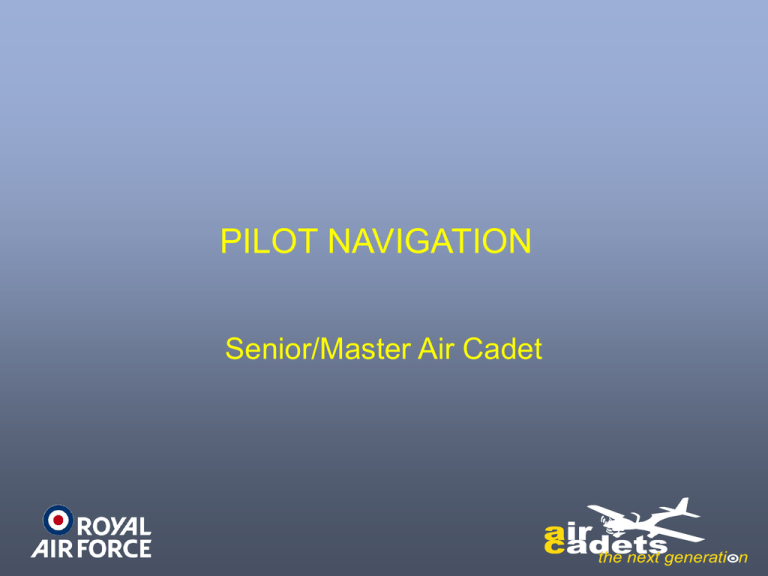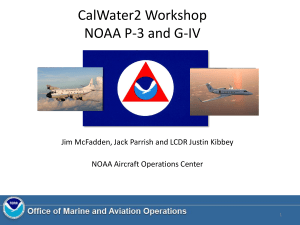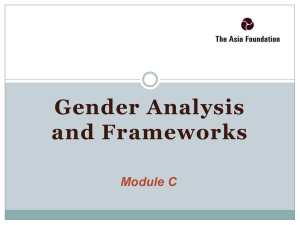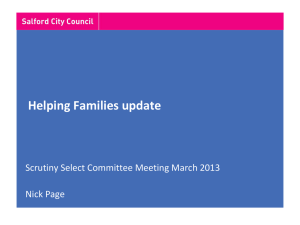Learning Outcome 3
advertisement

PILOT NAVIGATION Senior/Master Air Cadet THE WEATHER Introduction Previously you have learnt how the weather affects the hill walker, and the aviator in the circuit We will now see how the weather affects aircraft en route between airfields The Air In order to understand the reactions involved when the air is in motion we must consider its constituents The major variable is water as we shall see Pure air consists of : OXYGEN 20% NITROGEN 79% OTHER 1% (POLLUTION, OZONE, CO 2) Temperature & Pressure From your physics you will remember Boyles’s gas laws. If you don’t you should know that up high in the atmosphere (such as on top of a mountain) it is very cold and climbers need to carry oxygen This is because the air pressure is very low at high altitudes Temperature & Pressure The air pressure at sea level is caused by the weight of the air above us. The higher you go, the less the weight becomes If a gas is compressed it become hotter, & so the less compressed it is the colder it is Water Vapour A certain volume of air, under fixed conditions of pressure and temperature, can only hold a certain amount of water vapour, which is an invisible gas If this air becomes cooler it will not be able to hold as much moisture and will eventually become saturated with water vapour Water Vapour When the air cools to this point it is known as the dew point It is at this point that dew , mist or fog will form. If the temperature falls below freezing then frost or freezing fog will occur Cloud When unsaturated air rises the temperature drops & the dew point is reached, and cloud is formed DP AIR RISING DUE TO TRIGGER ACTION TEMPERATURE DROPPING Trigger Actions There are four trigger actions that force air to rise: Turbulence - air currents coming together Convection - heating of the air by the sun ?????? Trigger Actions Orographic uplift (mountain effect) air hitting mountain ranges Trigger Actions Frontal uplift - when 2 fronts meet Warm Front Warm air Cool Air The height of the cloud will depend on the amount moisture in the air, and the strength of the uplift In extreme cases Cumulo Nimbus thunder clouds form, and these are a severe hazard to aircraft At high levels the clouds (cirrus) consists of ice crystals, but most other clouds are formed by visible droplets of water Thunderstorms A large thunderstorm presents a variety of hazards, both in the cloud and surrounding areas, to aircraft and are best avoided Precipitation - all types are present - the most dangerous being hail Icing - as previously covered Lighting & thunder the main effect is psychological. Lighting often strikes aircraft but the main danger is to electrical systemsradar, radios etc, and temporary blinding of the crew ! Turbulence the air in a thunder cloud can be in vertical motion up or down in excess of 50 knots and can change from up to down and back again in seconds. This can destroy aircraft Landing hazards all of the above hazards exist under the base of the thunderstorm - the most significant being the risk of a severe down drought just as the aircraft is landing Most modern aircraft carry weather radar’s for detecting thunderstorms & turbulent air Isobars When watching the weather forecasts on TV you will have noticed that the air pressure changes from place to place The normal range of pressure is 930 millibars to 1050 millibars The pressure is shown on the chart by Linking areas of equal pressure by a line called an Isobar shown thus 1016 1016 L 1000 992 The isobars surround areas of high or low pressure, and show us how the wind is moving - the wind velocity (WV) The WV is always expressed as where it is coming from in degrees and its strength in knots For example a WV of 200/25 is a wind coming from 200° at 25 knots In the northern hemisphere the wind circulates clockwise around anti cyclones (high pressure areas) & anti clockwise around cyclones ( low pressure areas) 1016 L 1000 992 WIND To remember this stand with your back to the wind, and the area of low pressure is to your left This is reversed in the southern hemisphere Isobars – facts and figures Isobar patterns represent the wind at 2000’ above the surface Isobars – facts and figures The direction of the lines give the direction the wind The closer the lines the stronger the wind Isobars – facts and figures At the surface the wind is about 25% weaker than at 2000’ as a result of surface friction. It is also backed by about 25° For example: a wind at 2000’ of 270/20 will be 245/15 at the surface TAFs & METARs The weather forecaster uses many charts & symbols to convey the details of the weather over the whole country For an aviator, who receives info from radio, it must be coded & is standardized world wide (except Canada !) There are 2 formats: TAF Terminal Aerodrome Forecast M ETAR Meteorological Actual Report one records a forecast and the other reports actual conditions TAF Is published for a 9 hour period, and starts with 4 figures eg 0615 introduces a forecast valid from 0600 to 1500 hrs TAF TAFs do not include temperatures or pressures But may include information on expected changes TAF These are prefixed : BECMG - Becoming TEMPO - Temporary TAF If the forecaster is unsure then he gives a probability: PROB 30TS means 30% chance of thunderstorm METAR Gives the conditions at an airfield and is recorded hourly It is given to aircraft inbound It is normally prefixed by a time - which is the time the conditions where observed METAR If the weather changes rapidly a SPECI – (special) report is issued METARs & SPECIs Do not forecast conditions, but do include pressure & temperature The Code TAF CRANWELL 0615 260/05 4000 HZ SCT030 BECMG CAVOK= This translates as Cranwell/ for 0600 - 1500 hrs/ surface wind 260° true at 5 knots/visibility 4000 meters in haze/scattered cloud base at 3000’/becoming “cloud and visibility okay” that is the visibility will be at least 10km and no cloud below 5000’ CRANWELL 0615 260/05 4000 HZ SCT030 BECMG CAVOK= The Code METAR CRANWELL 0900 250/07 8000 FEW 035 +17/+13 1028= This translates as CRANWELL/ AT 0900 Z HRS/ SURFACE WIND 250° TRUE AT 7 KNOTS/VISIBILITY 8000 METERS/LOWEST CLOUD - few (EIGHTS) AT 3500’/TEMPERATURE +17°C, DEW POINT + 13°C/PRESSURE 1028 CRANWELL 0900 250/07 8000 FEW 035 +17/+13 1028= In the USA temperature is give in °F = Means End Of Message Pressure is the QNH at the airfield TAF and METAR codes Time: A 4 Figure Group In Hours/Minutes Wind: Wind Speed In Knots & Direction In Degrees True. In gusty conditions a “G” is added with A higher figure to indicate range – 18G28 Visibility: 4 Figures From 0000 To 9999. This Is The Visibility In Meters & Km Weather: 2 letter groups to indicate type of weather BR Mist FZ Freezing DZ Drizzle SN Snow FG HZ Haze RA Rain SH Shower TS Thunderstorm - Slight + Heavy Fog FU Smoke HZ Haze These can be mixed in any combination: RASN Rain & snow mixed +SHRA Heavy rain shower -FZDZ Light freezing drizzle Cloud: 6 item code giving cloud amount & height of cloud base Cloud Amounts: FEW 1 or 2 eighths coverage SCT Scattered 3 or 4 eighths BKN Broken 5 or 7 eighths OVC 8 eighths coverage Cloud Base: 3 numbers to indicate cloud base height above airfield in hundreds of feet, eg. 018 = 1800 feet Check of understanding What is a TAF? Terminal Aerodrome Forecast What is a METAR? Meteorological Actual Report If the weather changes rapidly a SPECI – (special) report is issued What is a SPECI?











